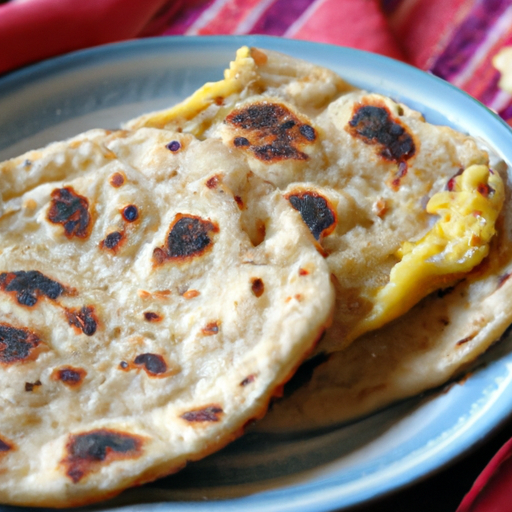Everything You Need to Know About Paratha Bread
Warm, buttery, and simply irresistible, paratha bread is a staple in Indian cuisine that is sure to tantalize your taste buds. This flaky and flavorful bread is a perfect accompaniment to any meal or a delicious snack on its own. In this blog post, we will explore the culinary wonders of paratha bread, including its taste, common uses in cooking, nutritional value, and some interesting history and facts.
Taste: A Melting Pot of Flavors
Paratha bread brings a delightful combination of textures and flavors to the table. The secret lies in the layers created during the rolling and folding process. When cooked to perfection, paratha boasts a crispy exterior and a soft, buttery interior. Its rich taste is subtly enhanced by the addition of spices like cumin, coriander, and turmeric, resulting in a truly indulgent experience for your taste buds.
Versatility in Cooking: From Breakfast to Dinner
Paratha bread is incredibly versatile and finds a place in various meals throughout the day. It can be enjoyed as a delicious breakfast option, often served with a side of yogurt, pickle, or spicy chutney. Stuffed parathas, known as “parathas with a twist,” are a popular variation. They are filled with a variety of enticing fillings such as spiced potatoes, paneer (Indian cottage cheese), or minced meat.
During lunch or dinner, paratha bread can act as a perfect accompaniment to curries and gravies, providing a delectable option for scooping up every last bit of flavorful sauce. It can also be enjoyed as a satisfying snack on its own, perfect for satisfying those afternoon cravings.
Nutritional Value: A Wholesome Delight
Paratha bread not only pleases the palate but also offers some nutritional benefits. Its primary ingredient, whole wheat flour, is a great source of complex carbohydrates, dietary fiber, and essential nutrients such as iron, magnesium, and B-vitamins. When cooked with minimal oil, paratha can be a healthier alternative to other bread options.
However, it’s important to keep in mind that parathas can be high in calories if excessive amounts of oil or ghee (clarified butter) are used during the cooking process. As with any food, moderation is key to enjoying paratha as part of a balanced diet.
History and Interesting Facts: Unveiling the Origins
Paratha bread has a rich history that dates back centuries. Its origins can be traced to the Indian subcontinent, where it is believed to have originated in the region of Punjab. Traditionally, parathas were prepared using ghee and were considered a luxurious treat, often reserved for special occasions or served to guests.
In addition to its delightful taste and versatile nature, paratha bread is also a significant cultural symbol. It is commonly enjoyed with family and friends, bringing people together over a meal. The art of making parathas has been passed down through generations, with each family adding their own unique touch to the recipe.
Conclusion
Paratha bread is a culinary gem that offers a delightful burst of flavors, versatility in cooking, and a dose of traditional culture. Whether enjoyed for breakfast, lunch, or dinner, this flaky delicacy is sure to leave a lasting impression on your taste buds. So why not give it a try? Prepare a batch of parathas and indulge in the magical world of Indian cuisine. Happy cooking!
Note: As with any dietary recommendations, please consult with a health professional if you have specific dietary restrictions or concerns.
Paratha Bread
Origin and Common Uses: Paratha is a type of unleavened flatbread that originated in the Indian subcontinent. It is particularly popular in India, Pakistan, and Bangladesh. Traditional parathas are made by rolling out dough, folding it into layers, and then frying it on a tawa (a flat griddle) with oil or ghee. Parathas can be plain or stuffed with various ingredients like vegetables, paneer (Indian cottage cheese), meat, or lentils. They are commonly served as a breakfast item or as a side dish with curries, chutneys, or yogurt.
Nutritional Benefits: Paratha bread is a good source of carbohydrates, which provide energy to the body. The type and amount of nutrients in paratha bread can vary depending on the ingredients used and the cooking method. Plain parathas made with whole wheat flour provide dietary fiber, which aids in digestion and can help maintain a healthy digestive system. Stuffed parathas can offer additional nutritional benefits depending on the filling, such as vitamins and minerals from vegetables or protein from paneer or meat.
Unique Properties and Historical Significance: Paratha bread stands out for its flaky, layered texture, which is achieved by folding and rolling the dough. This technique is similar to the process used for making puff pastry. The layers of paratha separate during cooking, creating a distinct texture that is crispy on the outside with a soft interior. Parathas have a long history in the Indian subcontinent and are considered a staple food in many regional cuisines. They have evolved and adapted over time, incorporating local flavors and ingredients.
Cultural Significance: Paratha bread holds cultural significance in the Indian subcontinent. It is not only a common food item but is also associated with hospitality and warmth. Parathas are often made with love and care in households and are served during family meals or as a special treat for guests. They are also popular street food, with vendors skillfully making and selling parathas on bustling corners. Parathas have gained international recognition due to their delicious taste and versatility, appealing to people of various culinary preferences around the world.




Use the share button below if you liked it.
It makes me smile, when I see it.